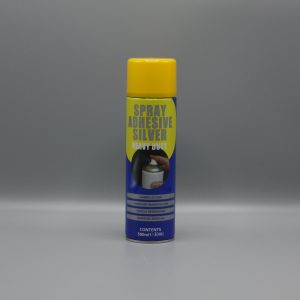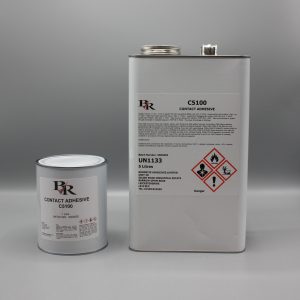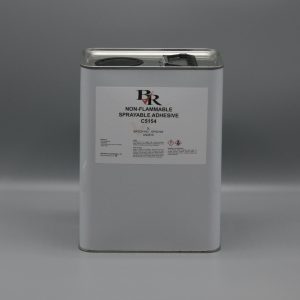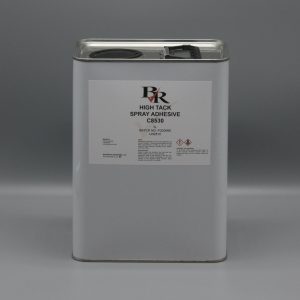Contact Adhesives for Rubber & Foam
Bondrite stock an extensive range of adhesives for open and closed cell foams as well as commercial grade rubber bonding. If you are looking for the best rubber or foam contact adhesive then you need look no further.
We stock spreadable/rollerable contact adhesives for easier application over larger areas without having to purchase spray equipment as well as sprayable contact adhesives and aerosols for fast, economic application.
Our dedicated team can offer bespoke advice on your specific type of rubber or foam but for quick reference see our handy table below.
| M1600 Spray can | For open cell foam creating a hard bond line, particularly useful in upholstery applications |
| C8530 – Sprayable | For open and closed cell foam creating a soft flexible bond to itself and other materials |
| C5154 – Non flammable | For rigid and flexible foam bonding to painted metal, chipboard, hardboard, fibreglass and other types of wood |
| C5004 – Waterproof | For closed cell foam like neoprene as well as natural, polychloroprene, butyl, nitrile and polyurethane rubber |
| C5100 – Spreadable | For rubber to a wide variety of other materials |
For bulk volumes or large quantities please call the office on 01509 815550 for a bespoke quotation.
Showing all 6 results
-

Adhesive spreader pack of 5
£6.00 Add to basket -

Contact Rubber Adhesive Kit – C5004
From: £19.73 Select options This product has multiple variants. The options may be chosen on the product page -

Heavy Duty Contact Adhesive Spray – M1600 – 500ML
£7.04 Add to basket -

Non-Flammable Sprayable Contact – C5154 – 5 Litre
£78.85 Add to basket -

Sprayable Foam Contact Adhesive C8530 – 5 Litre
£96.74 Add to basket
What are contact adhesives for rubber & foam?
Our range of adhesives for rubber and foam bonding are known as contact adhesives, which can create strong, flexible bonds with various types of foam to itself as well as other materials such as metal, wood and other commercial and industrial materials.
These high strength foam glues can be selected to have great temperature resistance, be non flammable or offer a waterproof bond.
These adhesives are suitable for various industries, and can be applied to both surfaces that are to be bonded and then allowed to dry before they are pressed together. The two surfaces are then joined together permanently, creating a strong, long-lasting bond.
Rubber & Foam Adhesives explored
If you aren’t sure which of our commercial grade rubber adhesives would be the best, or strongest, for your foam or rubber applications, then let’s explore this range of Rubber & Foam Contact Adhesives in more detail to find the best one you are looking for.
Ideal for or known as
These adhesives are ideal for the following types of use cases and applications, or known as:
- Rubber adhesive
- Glue for rubber foam
- Foam rubber adhesives
- Contact adhesive for rubber
- Contact adhesive for foam
- Foam bonding glue
- Foam bonding adhesive
- Foam glue
- Closed cell foam adhesive
- Flexible glue for foam
- Glue for foam board
- Rubber contact adhesive
- Adhesive for rubber to metal
- Rubber bonding adhesive
- Neoprene adhesive
- Rubber matting
- Rubber flooring
- Synthetic decoration panels
- DJ Equipment
- Wet contact adhesives for gluing foam
- Adhesive for rubber to wood
- Rubber glues
- Foam-bonding adhesive
- Wet contact adhesive foam
500ml Heavy Duty Contact Adhesive Spray – M1600
This Heavy-Duty Spray Contact Adhesive M1600 is a premium, fast, strong and high-tack contact spray adhesive aerosol which does not contain CFCs.
This adhesive can be used on a wide variety of materials including carpet and carpet tiles, felt, textiles, fabrics, insulation, wood, stone, concrete, plasters, some plastics, polythene, canvas, foam, cork, cardboard & paper.
It is used in flooring, furniture manufacturing and thermal insulation giving you a rapid and strong bond strength formation and is also economical in use.
Available in the following size:
- 500ml Heavy Duty Contact Adhesive Spray – M1600
High Performance Contact Adhesive – C5100
Performance Contact Adhesive C5100 based on polychloroprene rubber.
This adhesive is applied with a brush, and bonds to a wide variety of materials, and is an ideal contact adhesive for rubber to wood, and many other applications.
This adhesive forms a strong permanent contact bond between the following materials: laminates (e.g. Formica, Melamine), wood (e.g. MDF, plywood, hardboard), rubber, most plastics, metals, fabrics.
It is used for interior trimming in the automotive, marine and transportation industries.
Available in the following sizes:
- 1 Litre High Performance Contact Adhesive – C5100
- 5 Litres High Performance Contact Adhesive – C5100
Non-Flammable Sprayable Contact – C5154 – 5 Litres
Non-Flammable Sprayable Contact C5154 is a high performance contact glue offering excellent heat resistance up to 95°C.
It is ideal for the permanent bonding of all flexible foams to either themselves or to typical furniture materials such as painted metal, chipboard, hardboard, fibreglass and other types of wood.
It is equally suitable for the attachment of furnishing fabrics including backed PVC and backing materials such as hessian, felt and upholstery padding.
Non-Flammable Sprayable Contact C5154 has been developed to be applied with contact adhesive spray systems.
This commercial grade adhesive is used widely in the upholstery industry due to it’s non flammable property.
Available in the following size:
- 5 Litres Non-Flammable Sprayable Contact – C5154
Rubber Contact Adhesive Kit – C5004
Rubber Contact Adhesive Kit C5004 is is a two-part, solvent-based adhesive formulated on polychloroprene rubber.
This rubber adhesive will bond natural, polychloroprene, butyl, nitrile and polyurethane rubber materials and also rigid PVC, wood and leather.
It is particularly suitable for the fabrication of inflatable products such as boats, wet/dry suits, marine fenders and is also ideal for use in bonding rubber linings in storage tanks.
It is a two-component, high-performance adhesive system for a wide range of industrial applications, to provide an excellent water-resistant bond.
Available in the following sizes:
- 250ml Rubber Contact Adhesive Kit – C5004
- 500ml Rubber Contact Adhesive Kit – C5004
- 1 Litre Rubber Contact Adhesive Kit – C5004
Sprayable Foam Contact Adhesive – C8530 – 5 Litres
Sprayable Foam Contact Adhesive C8530 has been developed specifically for use in the upholstery and furniture industry.
It is a rubber based, low-pressure, non-flammable contact adhesive. This foam adhesive securely bonds flexible and soft foam (polyurethane) to itself, as well as a wide range of other materials, including wood, plastics and most metals.
Bonds are durable with excellent heat-resistance. This flexible foam glue also creates a soft bond line, which helps to simplify the cutting process during manufacturing and ensures a great finished product.
Sprayable Foam Contact Adhesive C8530 is designed to be applied with contact adhesive spray systems.
Available in the following size:
Available in the following size:
- 5 Litres Sprayable Foam Contact Adhesive – C8530
Looking for what glue to use on high density foam?
The first thing to note is that High Density Foam isn’t a single entity, there are a multitude of different types of foam and therefore no single answer to the question of how to bond it successfully.
However if you are looking for what sticks to foam we have created a guide below:
For an open cell type of foam (like a sponge) we would recommend using a spray adhesive with an excellent adhesion that that sits on the top of the foam rather than using a brushable product that will sink into the holes. For a hard bond line we stock Heavy Duty Contact Adhesive Spray – M1600 which is a hand held easy to apply sprayable contact adhesive which is commonly used in upholstery.
For a soft bond line again, we would suggest a sprayable product Sprayable Foam Contact Adhesive – C8530 which can be sprayed by hand and is also suited to upholstery applications.
For a closed cell type of foam (like neoprene) it depends on the application as to what we would recommend. If it needs to be waterproof such as for wetsuits or outdoor applications then our Contact Rubber Adhesive Kit – C5004 is a two-part contact adhesive which creates a strong waterproof bond. For high temperature requirements ie. anything over 50°C then we would suggest our Non-Flammable Sprayable Contact – C5154 which has the added benefits of being non-flammable and sprayable.
For applications where the foam needs to remain flexible, we would suggest Sprayable Foam Contact Adhesive – C8530 which can be applied as a single way stick but always works best applied to both surfaces.
For a rigid type of foam (like insulation panels) we would suggest Non-Flammable Sprayable Contact – C5154 as a non-flammable product it makes it particularly suited to domestic and building applications, with a great coverage per litre it is perfect for large areas.
For a polypropylene foam it is an incredibly difficult surface to create a structural bond so the adhesive needs to be as tacky as possible so we would suggest sprayable Foam Contact Adhesive – C8530; however, it is imperative to test this as it is a notoriously difficult material to bond.
When considering which adhesive to use for foam it is just as important to consider how you want to apply the adhesive, Ie. can it be sprayed or rollered and does the whole surface area need to be covered in order to create the bond or will a criss-cross pattern suffice in which case there is also the possibility of using products such as PU Panel Adhesive Soudaflex 40FC – P1005 or MS Polymer Sealant Fix All Crystal Clear – P1010.
We hope this guide helps you find the best adhesive for foam but if you are unsure as to which adhesive to use, feel free to
Can you bond rubber to metal?
Our best adhesives for gluing rubber to metal are our M1600, C5100 and C5154. Contact adhesives are designed to be applied to both surfaces and be well consolidated.
When bonding rubber or foam to metal or plastic, it is important to know how to use rubber adhesive, always ensure that the surfaces are clean, dry, and free of any dust, dirt, or other contaminants.
This can typically be achieved through a combination of wiping the surfaces with a clean, dry cloth, and using a solvent to remove any oils or other residues.
Once the surfaces are clean and dry, the contact adhesive can be applied to both surfaces and allowed to dry until it becomes tacky. The materials can then be joined together, and pressure can be applied to ensure a strong bond.
It is important to note that some plastics may be more difficult to bond than others, and some may require a special type of contact adhesive or a different bonding process altogether. Additionally, some metals may require a primer or other surface treatment to ensure a strong bond.
In general, it is recommended to follow the manufacturer’s instructions and conduct a small test bond to ensure that the materials will bond properly and form a strong and durable bond.
Can you use contact adhesive on rubber?
Contact adhesive is particularly good at bonding rubber as it has a similar base and similar materials create a better bond.
The solvent blend within a contact adhesive attacks the top layer of the rubber, diffusing the polymer chain and fusing it with the polymer chain within the adhesive itself. So similar polymer chains create better bonds.
Different contact adhesives have different resin qualities and solvent blends which means that they can be more tailored to specific types of rubber.
Can you bond rubber to metal?
Yes absolutely! Our best adhesives for gluing rubber to metal are our M1600, C5100 and C5154. Contact adhesives are designed to be applied to both surfaces and be well consolidated.
When bonding rubber or foam to metal or plastic, it is important to know how to use rubber adhesive, always ensure that the surfaces are clean, dry, and free of any dust, dirt, or other contaminants.
This can typically be achieved through a combination of wiping the surfaces with a clean, dry cloth, and using a solvent to remove any oils or other residues.
Once the surfaces are clean and dry, the contact adhesive can be applied to both surfaces and allowed to dry until it becomes tacky.
The materials can then be joined together, and pressure can be applied to ensure a strong bond.
It is important to note that some plastics may be more difficult to bond than others, and some may require a special type of contact adhesive or a different bonding process altogether. Additionally, some metals may require a primer or other surface treatment to ensure a strong bond.
In general, it is recommended to follow the manufacturer’s instructions and conduct a small test bond to ensure that the materials will bond properly and form a strong and durable bond.
What are popular types of contact adhesives for rubber and foam?
Some of our best sellers of contact adhesives for rubber and foam include neoprene-based adhesives, polychloroprene-based adhesives (also known as “CR” or “neoprene” adhesives), and solvent-based adhesives.
Neoprene-based adhesives are often used for bonding natural and synthetic rubber, while polychloroprene-based adhesives are commonly used for bonding foam materials.
Solvent-based adhesives are a good choice for bonding a wide variety of rubber and foam materials, but they require special care and handling due to their potentially hazardous chemical composition.
Another type of contact adhesive for rubber and foam is polychloroprene-based adhesive. Polychloroprene is also known as neoprene, but in this case, it refers to a specific type of neoprene polymer that is often used in adhesives. Polychloroprene-based adhesives are known for their excellent bonding strength and resistance to heat and chemicals.
They are often used for bonding foam materials, such as upholstery foam, foam rubber, and insulation foam.
Solvent-based adhesives are another option for bonding rubber and foam materials. These adhesives are typically made from a mixture of solvents, polymers, and other ingredients, and they can be used to bond a wide range of materials, including rubber, foam, plastics, and metals.
However, solvent-based adhesives can be hazardous to work with due to their volatile organic compound (VOC) content, so it’s important to know how to use rubber adhesives especially ensuring they are used in a well-ventilated area and you follow all safety precautions.
Important to follow the manufacturer’s instructions
When using contact adhesives for rubber and foam, it’s important to follow the manufacturer’s instructions carefully.
This may include applying the adhesive in a well-ventilated area and allowing it to dry completely before bonding the two surfaces together.
It’s also a good idea to test the adhesive on a small, inconspicuous area of the materials before applying it to the entire surface.
Versatile type of adhesives
Contact adhesives are a versatile type of adhesive that can be used to bond a wide range of materials, including rubber and foam.
These materials are commonly used in many different applications, from automotive and construction to crafting and DIY projects.
Whether you’re repairing a rubber gasket, making a foam cushion, or creating a rubber and foam costume piece, a contact adhesive can provide a strong, long lasting bond that will hold up over time.
How do contact adhesives work?
Contact adhesives work by creating a strong, permanent bond between two surfaces through a process called “mechanical interlocking.” When a contact adhesive is applied to a surface, its fast-drying properties allow it to dry to form a tough, rubbery layer. This layer is then pressed into contact with the other surface, which also has a layer of adhesive on it.
As the two adhesive layers come into contact, they begin to react chemically, causing them to soften and become tacky.
The two surfaces are then pressed together firmly, creating a strong, permanent bond. The bond is created by the interlocking of the two adhesive layers, as well as by the chemical reactions that occur between the adhesive and the surfaces it is bonding.
It’s important to note that contact adhesives are designed to be applied to both surfaces that are to be bonded, rather than just one.
This is because the adhesive needs to react with both surfaces in order to create a strong, long lasting bond.
If the adhesive is only applied to one surface, it may not bond effectively, and the bond may fail over time.
What makes contact adhesives a good choice for bonding rubber and foam materials?
Contact adhesives are a good choice for bonding rubber and foam materials for several reasons.
One of the main reasons is that contact adhesives are designed to be flexible and durable, which makes them ideal for bonding materials that may be subject to stress, strain, and vibration over time.
Another advantage of contact adhesives is that they can be used on both porous and non-porous surfaces, which means they can be used to bond a wide range of rubber and foam materials.
Additionally, contact adhesives are typically resistant to water and some chemicals, which can help ensure a strong, long-lasting bond in a variety of environments.
Can contact adhesives be used for bonding different types of rubber, such as natural rubber and synthetic rubber?
Yes, contact adhesives can be used for bonding different types of rubber, including both natural and synthetic rubber.
However, it is important to select the appropriate type of contact adhesive for the specific type of rubber being bonded. Some contact adhesives may be better suited for certain types of rubber than others.
Natural rubber, for example, can be bonded well with neoprene-based contact adhesives, while synthetic rubbers like EPDM and SBR may require a different type of contact adhesive.
It is also important to note that some rubber materials may contain oils or other additives that can affect the bonding process, so it is always a good idea to test the adhesive on a small, inconspicuous area before applying it to a larger surface.
How long does it take for contact adhesives to dry when used on rubber or foam?
The drying time for contact adhesives used on rubber or foam can vary depending on a variety of factors such as temperature, humidity, and the type of adhesive being used.
In general, contact adhesives require a period of time to dry and become tacky before the materials can be bonded. This is typically referred to as the “open time” of the adhesive. Once the open time has passed, the materials can be joined together and the bond will start to develop.
The open time for contact adhesives can range from a few minutes to several hours, depending on the specific adhesive being used. Some adhesives may require a longer open time to allow for proper bonding, while others may have a shorter open time and require a quicker bonding process.
Once the materials are joined together, the bond will typically reach full strength within 24 to 48 hours, although it may take longer for the bond to fully cure and reach a high strength.
It is important to follow the manufacturer’s instructions and allow the recommended drying and curing times to ensure a strong and long-lasting bond.
Price of Rubber & Foam Contact Adhesives
Rubber & Foam Adhesives can be even more cost effective when bought in bulk. All of our adhesives have bulk buy discounts which are automatically applied at the checkout. There is no need for a discount code.
Shipping Information
When it comes to shipping options we can can ship to anywhere in the United Kingdom, and Northern Ireland, with free UK delivery options on orders over £50 to the mainland UK.
Shelf life
Many of these adhesives and adhesive sealants, especially designed for rubber and foam, come with a 12-month shelf life.
Not sure if Rubber & Foam Contact Adhesives are right for your requirements?
If you are not sure if these adhesives are correct for your requirements, of if you require the safety data sheets, or technical data sheets, for these purpose contact adhesives, please contact our customer support team to discuss your requirements and we can point you in the right direction.





